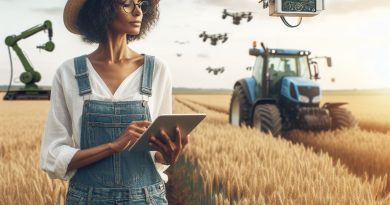US Farming: Adapting to Global Demands
Last Updated on February 8, 2024
Introduction
Importance of the topic
The global demand for food has been steadily rising in recent years.
As a result, it is essential for the US farming industry to adjust and evolve to meet these demands efficiently.
The United States has long been regarded as a major player in the agricultural sector, and its ability to adapt is crucial for food security, economic stability, and sustainability.
Overview of US farming industry
The US farming industry plays a vital role in providing food for both domestic consumption and international markets.
With a diverse range of crops and livestock, the industry has the capacity to meet the global demand.
However, to remain competitive and ensure long-term success, it is necessary to embrace technological advancements, implement sustainable practices, and respond to changing consumer preferences.
US farming is adjusting and evolving to meet global demands
Diversification is one of the key strategies employed by US farmers to adapt to global demands.
By cultivating a wide variety of crops, farmers can cater to the varying needs of different countries and market segments.
Additionally, the industry has embraced precision agriculture techniques that optimize resource utilization and minimize environmental impact.
Another important aspect of US farming is innovation and technological advancements.
The introduction of advanced machinery, genetic engineering, and data analytics has revolutionized the industry, allowing farmers to improve productivity, efficiency, and sustainability.
These advancements enable farmers to produce high-quality crops and livestock while minimizing waste and environmental degradation.
Therefore, US farming is actively adjusting and evolving to meet the growing global demands for food.
Through diversification, technological advancements, and sustainable practices, the industry ensures its ability to deliver high-quality products while promoting economic growth and environmental stewardship.
Adapting to global demands is not only essential for the US farming industry but also crucial for the overall welfare and stability of the global food supply.
Background of US Farming
Brief History of US Agriculture
Agriculture has been an integral part of the United States since its early days.
The Native Americans were the first farmers, cultivating maize, beans, and squash.
When European settlers arrived, they brought new crops and technology, significantly expanding agricultural practices.
During the colonial era, farming became the backbone of the economy, and agriculture continued to flourish even after the country gained independence.
In the 19th century, advancements in machinery and transportation revolutionized farming, leading to increased productivity and specialization.
The introduction of the steel plow, reaper, and combine harvester transformed the agricultural landscape.
The expansion of railroads allowed farmers to transport their products more efficiently to markets across the country.
In the early 20th century, the Dust Bowl, coupled with the Great Depression, posed significant challenges to American farmers.
The government responded with policies like the New Deal, which aimed to improve farming practices, support rural communities, and stabilize agricultural prices.
Following World War II, technological advancements and mechanization further boosted productivity.
The Green Revolution of the 1950s and 1960s introduced high-yielding crop varieties, synthetic fertilizers, and pesticides, significantly increasing output.
Today, the United States is one of the largest agricultural producers in the world.
Farming practices have evolved to meet changing demands, with a focus on efficiency, sustainability, and global competitiveness.
Current State of US Farming Industry
The US farming industry is characterized by a high level of productivity and technological advancement.
Farmers employ cutting-edge machinery and precision agriculture techniques to maximize yields while minimizing environmental impact.
The industry is predominantly made up of family-owned farms, with a small percentage of large-scale operations.
However, consolidation has become a trend, as smaller farms merge or are acquired, leading to larger, more efficient operations.
Crop production in the United States is diverse, with corn, soybeans, and wheat being the predominant crops.
Livestock production also plays a significant role, with cattle, pigs, and poultry being the primary sources.
US farmers face various challenges, including global competition, changing weather patterns, and fluctuating commodity prices.
Trade policies and regulations also impact the industry, as farmers rely on export markets for their products.
Additionally, sustainability and environmental concerns are gaining importance.
Farmers are adopting practices like conservation tillage, crop rotation, and precision nutrient management to reduce the environmental footprint of agricultural activities.
Furthermore, advancements in biotechnology have resulted in the development of genetically modified crops, improving pest resistance and reducing the need for chemical inputs.
Despite the challenges, US farmers continue to adapt and innovate.
They embrace technology, invest in research and development, and actively participate in agricultural organizations to stay competitive in the global market.
As the world population grows and food demand increases, US farming must continue adapting to meet global demands.
Ensuring a sustainable and productive agricultural sector is crucial for food security, economic stability, and environmental conservation.
Read: Tech in Farming: Global Market Revolution
Global Demands on US Farming
Increasing population and food demand
- The world’s population continues to grow at a rapid pace, leading to an increase in food demand.
- As more people inhabit the planet, there is a greater need for sustainable and efficient farming practices.
- US farming plays a crucial role in meeting the global demand for food, as it has one of the largest agricultural sectors worldwide.
- Farmers in the US face the challenge of producing enough food to feed not only the domestic population but also the world.
- This increasing demand necessitates advancements in technology and farming techniques to maximize productivity and yield.
- The agriculture industry must adapt to this global demand by implementing innovative strategies to meet the growing food requirements.
Shift in dietary preferences
- Changing dietary preferences worldwide also impact US farming practices.
- With the rise of awareness about health and nutrition, more people are opting for healthier dietary choices.
- Consumers are increasingly demanding fresh produce, organic foods, and sustainably-raised animal products.
- This shift in preferences has led to a transformation in US farming methods to meet the demand for healthier and more sustainable options.
- Farmers are diversifying their crops and investing in organic farming practices to cater to the changing dietary preferences of consumers.
- The agriculture industry has also witnessed an increase in the production and marketing of specialty crops.
Rising demand for organic and sustainable products
- Alongside changing preferences, there is a growing demand for organic and sustainable products.
- Consumers are increasingly concerned about the environmental impact of conventional farming methods.
- As a result, US farmers are adopting sustainable practices, such as reducing chemical inputs and improving soil health.
- Organic farming methods, which avoid the use of synthetic pesticides and fertilizers, are gaining popularity.
- To meet this rising demand, farmers are transitioning to organic production and seeking certification.
- The demand for organic and sustainable products presents opportunities for US farmers to differentiate themselves in the global market.
Most importantly, US farming is facing global demands that require adaptation to ensure food security and meet changing preferences.
With the increasing population and food demand, farmers must embrace technological advancements to enhance productivity.
The shift in dietary preferences towards healthier options necessitates diversification and organic farming practices.
Additionally, rising demand for sustainable products highlights the need for environmentally conscious farming methods.
US farmers have the opportunity to capitalize on these global demands by incorporating sustainable and organic practices while striving to meet international food requirements.
Read: Climate Change: Shaping Global Agri Trade
Challenges Faced by US Farmers
Competition from international markets
The first significant challenge that US farmers face is competition from international markets.
With globalization, agricultural products from around the world are readily available in US markets, creating intense competition.
Farmers are now required to improve their productivity and efficiency to maintain a competitive edge in the international market.
Furthermore, countries with lower labor and production costs often pose a threat to US farmers, who struggle to compete with cheaper imports.
Climate change and extreme weather events
Another major challenge faced by US farmers is climate change and its associated extreme weather events.
Rising temperatures, droughts, floods, and unpredictable weather patterns threaten crop yields and livestock production.
These extreme weather events not only result in crop failures and livestock losses but also create uncertainty in the farming industry.
Farmers are forced to adapt their farming practices by implementing new technologies and techniques to mitigate the effects of climate change.
Rising input costs and limited resources
Farmers in the US also face the challenge of rising input costs and limited resources.
The cost of fertilizers, machinery, seeds, and other essential inputs continues to increase, affecting profit margins.
Additionally, limited access to water and land restricts the expansion of agricultural operations, especially in densely populated areas.
Farmers must find innovative ways to optimize their resources and reduce production costs while ensuring sustainable farming practices.
In essence, US farmers encounter several challenges as they adapt to global demands in the farming industry.
Competition from international markets, climate change, and rising input costs pose significant obstacles.
To overcome these challenges, farmers must embrace technology, implement sustainable farming practices, and continuously innovate to remain competitive.
By addressing these challenges head-on, US farmers can navigate the global market and contribute to the nation’s food security and economic growth.
Read: Global Organic Markets: Farming’s Future?

Adaptations in US Farming Practices
Technological advancements and precision farming techniques
- Technology has played a vital role in transforming US farming practices.
- Advanced machinery and equipment increase efficiency and productivity on farms.
- Precision farming techniques utilize satellite imagery and sensors to optimize resource allocation.
- These technologies enable farmers to monitor crops, soil conditions, and weather patterns accurately.
- With precision farming, farmers can apply fertilizers and irrigation precisely, reducing waste and increasing yields.
- Real-time data analysis helps farmers make informed decisions about crop management and resource allocation.
Diversification of crops and livestock
- Traditional farming focused on a limited range of crops, leaving farmers vulnerable to market fluctuations.
- Farmers diversify their crops to adapt to shifting consumer demands and climate changes.
- Diverse crop rotations improve soil health, reduce pests, and enhance overall farm resilience.
- Livestock diversification promotes sustainable agriculture by reducing dependence on a single commodity.
- Farmers may integrate livestock into their operations for meat, dairy, or even renewable energy production.
- Diversification provides farmers with multiple revenue streams and reduces the risks associated with monoculture.
Focus on sustainable practices and organic farming
- US farmers recognize the need to prioritize sustainability and reduce the environmental impact of agriculture.
- Sustainable practices include implementing conservation methods, such as cover cropping and integrated pest management.
- Organic farming eliminates synthetic inputs and focuses on regenerative practices that preserve soil quality.
- Farmers adopt organic certification to meet the increasing consumer demand for organic products.
- Sustainable and organic practices promote biodiversity, protect natural resources, and mitigate climate change effects.
- Growing awareness of the importance of sustainable practices encourages more farmers to adopt organic farming methods.
In fact, US farming has undergone significant adaptations to meet global demands.
Technological advancements have revolutionized farming practices, allowing for precise resource allocation and data-driven decision-making.
Diversification of crops and livestock provides farmers with resilience and multiple revenue streams.
Additionally, the focus on sustainable practices and organic farming promotes environmental conservation and meets consumer preferences.
These adaptations ensure that US farming remains competitive, resilient, and sustainable in the face of evolving global demands.
Read: EU Trade Policies and US Farm Exports
Government Support and Policies
Role of government in assisting farmers
- The government plays a crucial role in providing support and assistance to farmers.
- It offers financial aid, subsidies, and loans to help farmers enhance their agricultural practices.
- Government agencies also provide training and education programs for farmers to improve their skills.
- Furthermore, the government helps farmers access vital resources like land, water, and machinery.
- By assisting farmers, the government ensures sustainable and efficient farming practices in the country.
Policies promoting agricultural innovation and exports
- Governments implement policies to encourage agricultural innovation and technological advancements.
- These policies aim to enhance productivity, reduce inputs, and promote sustainable farming methods.
- Financial incentives and research grants are provided to encourage the development of innovative farming techniques.
- The government also supports the adoption of modern technologies, such as precision agriculture and biotechnology.
- These policies help farmers maximize their yields while minimizing the environmental impact.
- In addition to innovation, governments also play a crucial role in promoting agricultural exports.
- Export promotion policies include trade agreements, market access negotiations, and tariff reductions.
- Governments provide financial support to farmers for market research, product development, and export logistics.
- By promoting agricultural exports, the government ensures economic growth and stability in the farming sector.
- These policies aid in expanding the market reach of farmers and increasing their profitability.
In summary, the government’s involvement in supporting farmers and implementing policies is vital for the growth and sustainability of the agricultural sector.
By providing financial aid, training, and resources, the government assists farmers in improving their practices and ensuring their success.
The promotion of agricultural innovation and exports through policies fosters technological advancements, enhances productivity, and boosts economic growth.
Ultimately, the government’s support and policies contribute to the adaptation of US farming to meet global demands.
Case Studies of Successful Adaptations
Examples of farms implementing new techniques and technologies
These case studies highlight the success achieved by farms that have adapted to global demands by embracing new techniques, technologies, and marketing strategies.
They demonstrate the importance of staying innovative and forward-thinking in the ever-evolving agricultural industry.
Spencer Farms implementation of precision agriculture techniques showcases how data-driven decision-making can optimize crop yields.
By analyzing soil data, weather patterns, and growth conditions, they were able to make more informed choices regarding irrigation, fertilizer applications, and pest management.
This resulted in increased productivity and profitability for the farm.
Similarly, Food Springs Farms use of drones revolutionized their crop monitoring and analysis processes.
They could quickly identify potential issues such as pest infestations or nutrient deficiencies, allowing them to take swift corrective actions.
The adoption of this technology not only improved their crop quality but also reduced costs associated with manual labor and damage prevention.
Hydroponic farming at Larder Barns Farm proved to be a game-changer in meeting global demands.
By growing crops in a controlled environment with nutrient-rich water solutions, they achieved higher yields while using less land and water compared to traditional methods.
This allowed them to cater to the rising demand for fresh produce while minimizing the environmental footprint associated with conventional farming practices.
Water scarcity is a significant concern for many farms worldwide, and Jim and Sons Farms addressed this issue through automated irrigation systems.
By precisely delivering water to crops based on their specific needs, they reduced wastage and optimized water usage.
This not only saved costs but also ensured sustainable water management, aligning with global demands for responsible farming.
Vertical farming techniques implemented by Angus Farm allowed them to maximize space utilization by growing crops vertically in stacked layers.
This innovative approach enabled them to grow more crops in a smaller area, promoting efficiency and minimizing the need for expansive farmland.
By offering year-round produce, they can meet global demands consistently and reduce the reliance on seasonal availability.
Success stories in meeting global demands and increasing profitability
Michal Stephens Farm successful transition to organic farming demonstrates the power of consumer-driven shifts in global demands.
As more consumers become concerned about environmentally friendly and healthy food options, Farm MNO capitalized on this trend.
By eliminating the use of synthetic pesticides and fertilizers, they could attract a growing customer base seeking organic products and command premium prices.
Johnson Eats Farm’s ability to adapt to changing consumer preferences played a vital role in meeting global demands.
By diversifying their crop portfolio to include trendy crops like avocados and specialty fruits, they stayed ahead of market trends.
This allowed them to tap into new markets and increase profitability by catering to a broader range of consumer preferences.
Sustainable farming practices at Keniel Farms highlights their commitment to responsible agriculture.
By prioritizing soil health, reducing chemical usage, and promoting natural pest control methods, they positioned themselves as an eco-conscious farm.
This resonated with environmentally conscious consumers and enabled them to build a loyal customer base that values sustainability.
Farm Xavier Farm’s success in meeting global demands was driven by innovative marketing strategies.
They effectively communicated their farm’s story, emphasizing the importance of locally sourced, fresh produce.
By partnering with local restaurants and establishing direct-to-consumer sales channels, they created a unique selling proposition that captivated customers and created a competitive edge.
Vinner Farm’s partnership with local restaurants showcased the power of collaboration.
By supplying fresh produce directly to these establishments, they ensured a premium market for their crops while establishing strong relationships with influential chefs.
Additionally, implementing direct-to-consumer sales channels allowed them to connect with health-conscious consumers seeking high-quality farm-fresh produce.
Overall, these case studies demonstrate the adaptability and resilience of farms in meeting global demands.
Whether through new techniques, technologies, or marketing strategies, successful adaptations led to increased profitability and customer satisfaction.
Embracing innovation is essential for farms to thrive in an increasingly competitive and evolving agricultural landscape.
Benefits and Impacts on the US Economy
Contribution of US farming to the economy:
- US farming plays a crucial role in contributing to the strength of the nation’s economy.
- It is a significant sector that generates substantial revenue and drives economic growth.
- The agricultural industry contributes billions of dollars to the Gross Domestic Product (GDP) each year.
- With its vast production capacity, US farming supports various downstream industries and businesses.
- From supplying raw materials to food processing and manufacturing, agriculture fuels economic activities across multiple sectors.
Job creation and rural development
- US farming not only contributes to the economy but also plays a crucial role in job creation.
- It provides employment opportunities for millions of Americans, directly and indirectly.
- From farmers and agricultural laborers to food processors and distributors, the sector sustains a diverse range of jobs.
- Moreover, farming activities lead to rural development by providing income sources and stimulating local economies.
- Small towns and rural areas heavily rely on farming for their growth and prosperity.
Implications for trade and exports
- The success of US farming has far-reaching implications for international trade and exports.
- As one of the major agricultural exporters in the world, the US benefits from a positive trade balance.
- Its ability to produce and export large quantities of agricultural products strengthens its position in global markets.
- The demand for US agricultural goods contributes to the country’s export revenue and supports trade relationships with other nations.
- Moreover, US farming helps in sustaining food security globally by meeting the needs of countries that rely on imports.
In short, US farming holds immense significance for the economy, job creation, and trade. It is not only a critical contributor to GDP but also a sector that generates employment opportunities.
The success of US farming has positive implications for international trade, as the nation becomes a major player in the global agricultural markets.
Moreover, the industry helps meet global food demand, supporting food security worldwide.
Thus, the adaptation of US farming to global demands benefits not only the nation but also has far-reaching impacts across nations and economies.
Conclusion
Recap of main points discussed
The US farming industry is facing numerous challenges due to global demands.
We examined the importance of technological advancements and sustainable practices in meeting these demands.
Additionally, we discussed the need for diversification and innovation to remain competitive in the global market.
Furthermore, we highlighted the significance of government support and collaboration between different sectors.
Optimistic outlook for US farming industry
While the challenges can be overwhelming, there is reason for optimism in the US farming industry.
With a rich history of resilience and adaptability, American farmers have shown their ability to overcome obstacles.
The implementation of new technologies and sustainable practices provides hope for improved productivity and profitability in the future.
Call to action for continued support and adaptation to global demands
In order for US farming to thrive in the face of global demands, continued support and adaptation are essential.
It is crucial for stakeholders, including the government, farmers, and consumers, to recognize the importance of sustainable agricultural practices.
By investing in research and development, promoting education, and fostering innovation, we can ensure the long-term success of the US farming industry.


